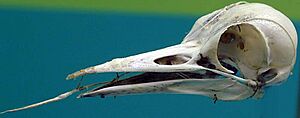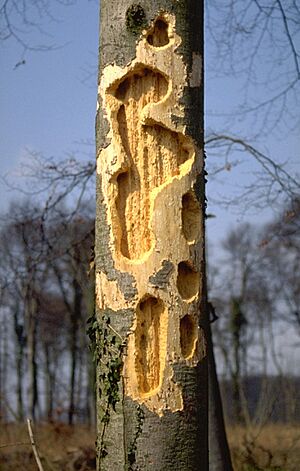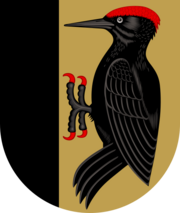Black woodpecker facts for kids
Quick facts for kids Black woodpecker |
|
|---|---|
 |
|
| Adult female | |
| Conservation status | |
| Scientific classification | |
| Genus: |
Dryocopus
|
| Species: |
martius
|
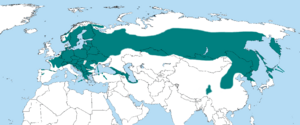 |
|
| Black woodpecker range | |
| Synonyms | |
|
Picus martius Linnaeus, 1758 |
|
The black woodpecker (Dryocopus martius) is a very large woodpecker. It lives in old forests across northern Europe and Asia. This bird is the only type of Dryocopus woodpecker found in this area. Its home range is actually growing bigger!
The black woodpecker is the biggest woodpecker in Europe and Asia. It's also one of the largest woodpeckers in the world. This bird does not migrate, meaning it stays in the same place all year. It likes to live in very old forests or big groups of trees. It digs large holes in trees to live in. Other animals often use these holes after the woodpecker leaves. Black woodpeckers mostly eat carpenter ants. This bird is similar to the pileated woodpecker in North America and the lineated woodpecker in South America.
Contents
Discovering the Black Woodpecker
The black woodpecker was first officially described in 1758. A Swedish scientist named Carl Linnaeus gave it the scientific name Picus martius. This happened in his famous book, the Systema Naturae.
Today, the black woodpecker is part of the Dryocopus group. This group was named by a German scientist, Friedrich Boie, in 1826.
There are two main types, or subspecies, of the black woodpecker:
- D. m. martius (Linnaeus, 1758): This type lives from western Europe all the way to Japan.
- D. m. khamensis (Buturlin, 1908): This type is found in Tibet and southwestern China.
What Does a Black Woodpecker Look Like?
The black woodpecker is about 45 to 55 centimeters (18 to 22 inches) long. Its wings can spread out 64 to 84 centimeters (25 to 33 inches). It usually weighs between 250 and 400 grams (9 to 14 ounces). It has a very long beak, about 5 to 6.7 centimeters (2 to 2.6 inches).
This bird is completely black, except for a bright red patch on its head. Male woodpeckers have a full red crown. Females only have a red patch on the back of their head. Young black woodpeckers look similar but are not as shiny. Their red patch is duller, and their throat and beak are lighter gray.
Black woodpeckers have bright yellow eyes. Their calls are very unique. One call is a loud, whistling kree-kree-kree. They also make a screeching sound when they fly. Unlike many other woodpeckers, they fly with slow, steady wing beats.
Where Black Woodpeckers Live
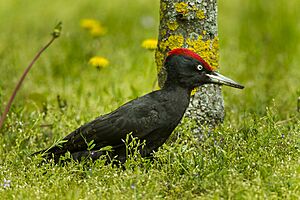
Black woodpeckers live across Europe, starting from Spain. They are not found in Great Britain, Ireland, or northern Scandinavia. They also live in parts of Asia, like Korea, Japan, and China. You can find them in the Middle East too, in places like Iran and Kazakhstan.
These woodpeckers mostly live in forests. They prefer large, old woodlands. This includes coniferous (cone-bearing) forests and boreal forests (cold northern forests). They can be found in both mountains and lowlands. Sometimes, they might be seen near towns when they are not breeding. They can live at heights from 100 to 2400 meters (330 to 7,900 feet).
How Black Woodpeckers Live and Behave
Black woodpeckers find food by hammering on dead trees with their strong beaks. They dig out carpenter ants and beetle larvae that live inside the wood. Their diet is quite specific. Like all woodpeckers, they have very strong neck muscles. These muscles help them hit trees over and over again.
Because of their large size and powerful beak, they can reach prey deep inside a tree. They have short, strong legs and sharp claws to hold onto the tree. Their stiff tail feathers also help them balance.
For their nests, woodpeckers often choose trees with a fungal disease. This makes the wood softer to dig. Once they start a hole, they dig downwards into the tree trunk. This creates a nesting chamber. The nest is lined only with woodchips from their digging.
The holes made by black woodpeckers are very important. Many other birds and mammals use these holes as homes after the woodpeckers leave. This makes the black woodpecker a "keystone" species. It means they are very important for their habitat. They not only provide homes but also help control wood-boring insects. This protects the trees.
When the nest is ready, the female lays 2 to 8 eggs, usually 4 to 6. The nest hole is often in a live poplar or pine tree. Both parents take turns sitting on the eggs. They also share the job of feeding the chicks after they hatch. The young birds leave the nest after 18 to 35 days. They stay with their parents for about another week.
Black Woodpecker Status
The black woodpecker is found in many woodlands. It can breed successfully where there are enough large forests. In the past, when many forests in Europe and Asia were cut down, their numbers went down. They still struggle in some areas, like the Pyrenees mountains. They need old trees and plenty of dead trees to have healthy families.
However, as some forests have grown back, black woodpecker numbers have increased in parts of Europe. Sometimes, people see them as a problem. This is because they can damage power lines, phone poles, and even houses. Sadly, this can sometimes lead to the woodpeckers getting hurt or killed.
The biggest reason why nests fail is because of predators. The main natural predator is the pine marten. These animals eat eggs, young birds, and even the mother bird. Then, they often take over the woodpecker's nest hole for themselves. Other animals like Western jackdaws might also take over nests or eat eggs. A few large birds of prey, like Ural owls and northern goshawks, might also hunt black woodpeckers.
Black Woodpecker in Culture
The town of Nurmijärvi in Finland has chosen the black woodpecker as its special bird. This is because it's the most common bird there. It also appears in stories by Aleksis Kivi, a famous Finnish writer from Nurmijärvi. The local football club, NJS, also uses the black woodpecker in its logo.
Some ancient texts from Italy, called the Iguvine Tablets, mention a woodpecker. Many believe this refers to the Dryocopus martius martius. This bird was very important in early Italian religions and myths.
See also



